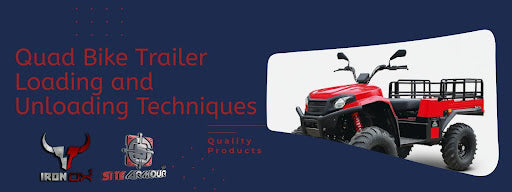
Quad Bike Trailer Loading and Unloading Techniques
Proper loading and unloading techniques are required to transport your quad bike safely and efficiently. Whether heading to a trail, a competition, or just moving your quad from one location to another, knowing the right methods can prevent accidents and ensure your vehicle and trailer remain in top condition.
Experts agree that proper loading and unloading techniques ensure safety and efficiency when transporting quad bikes. In this guide, we'll walk you through the best practices for loading and unloading your quad bike, drawing on industry expertise to help you confidently navigate these critical tasks.
1. Preparing for the Load
Before loading your quad bike onto a trailer, ensure you’re fully prepared:
- Choose the Right Trailer: Ensure the trailer suits your quad bike's size and weight. An ideal trailer has a load capacity greater than the combined weight of the quad and any additional equipment.
- Check the Trailer Condition: Inspect the trailer for ramps, tires, and hitch damage or issues. Ensure the trailer is properly hitched to your vehicle.
- Gather Necessary Equipment: Have all necessary equipment ready, including wheel chocks, tie-down straps, and a ramp. For added safety, you might also want to wear gloves and a helmet.
2. Loading the Quad Bike
Step 1: Position the Trailer and Quad Bike
- Park on Level Ground: Ensure the trailer is parked on a flat surface. This helps in maintaining stability while loading.
- Align the Trailer and Quad: Position the quad bike directly in line with the trailer ramp. If possible, have a spotter assist with aligning the vehicle.
Step 2: Secure the Ramp
- Check Ramp Stability: Ensure the ramp is securely attached to the trailer and can support the weight of the quad bike. Some ramps are designed to lock in place, while others may need to be secured with additional straps.
Step 3: Load the Quad Bike
- Drive Slowly: Carefully drive the quad bike up the ramp and onto the trailer. Keep a steady speed and avoid sudden movements.
- Use a Spotter: If you need clarification on the ramp's stability or the loading angle, have someone help guide you.
Step 4: Secure the Quad Bike
- Use Wheel Chocks: Place wheel chocks behind the rear wheels to prevent movement while the bike is on the trailer.
- Tie-Down Straps: Attach tie-down straps to secure the quad bike in place. Fasten the straps to the trailer’s anchor points, ensuring the bike is stable and upright. Avoid overtightening, which can damage the bike or the trailer.
3. Unloading the Quad Bike
Step 1: Prepare for Unloading
- Remove Wheel Chocks: Remove the wheel chocks from behind the rear wheels before unloading.
- Double-Check Stability: Ensure the trailer is on a stable surface and the ramp is securely attached.
Step 2: Unload the Quad Bike
- Drive Slowly: Carefully drive the quad bike down the ramp. Keep your speed slow and steady to avoid slipping or tipping.
- Use a Spotter: Having a spotter can help guide the quad bike safely down the ramp.
Step 3: Inspect and Clean
- Check the Bike: After unloading, inspect your quad bike for any damage or issues that may have occurred during transport.
- Clean the Trailer: To maintain its condition, ensure the trailer is free of mud or debris from the quad bike.
4. Safety Tips
- Wear Safety Gear: Always wear appropriate safety gear, including a helmet and gloves, while loading and unloading.
- Avoid Overloading: Never overload your trailer. Follow the manufacturer's guidelines for maximum load capacity.
- Be Mindful of Weather Conditions: Wet or icy conditions can make ramps slippery and increase the risk of accidents. Be extra cautious in adverse weather.
- Regular Maintenance: Regularly maintain your trailer and quad bike to ensure they are in good working condition. This includes checking the trailer’s brakes, lights, tires, and the quad bike’s fluid levels and tires.
Proper loading and unloading techniques are crucial for safely and efficiently transporting your quad bike. According to experts, these techniques are fundamental to trailer maintenance and vehicle safety. By adhering to these guidelines, you ensure that your trailer remains in good condition and your quad bike is transported without incident. Regular checks and maintenance will enhance safety and prevent unnecessary wear and tear.
